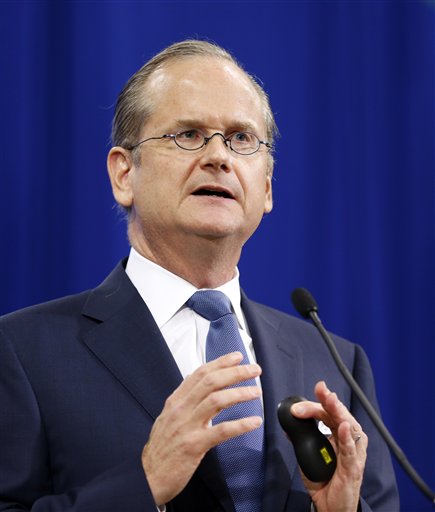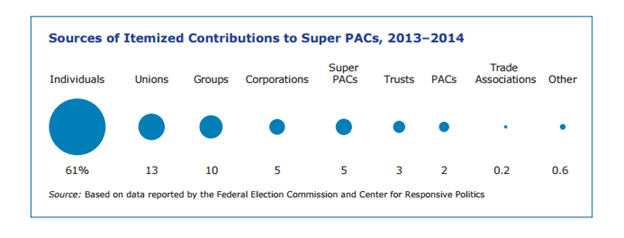“We’ve now created the green primary, where only the funders get to vote and they vote on who will have the money necessary to run their campaigns.” That’s how Harvard Professor-turned-political activist Larry Lessig describes politics today, drawing explicit comparisons to “white primaries” in the Jim Crow south that systematically disenfranchised African-American voters. Lessig formed a super PAC and ran for president on the platform that nothing meaningful can be accomplished in this country until we excise the cancer of the “green primary” that he believes is corrupting the heart of our democratic system.
Given that Lessig believes the “system is rigged,” one might imagine that the downfall of his own presidential campaign might involve the same undemocratic elements he rails against. That is, “money in politics” would prevent a successful Lessig campaign: perhaps wealthy Americans would be unwilling to support him, or would flock to his rivals, or flood the airwaves with negative ads about his candidacy and his policies. But in “Why I Dropped Out,” a post-mortem of his failed presidential campaign appearing in The New Yorker, Lessig appears to have run into a very different set of obstacles. Ironically, the problems “Candidate Lessig” faced illustrate just how wrong “Reformer Lessig” is about money’s role as a barrier to entry in politics.
In fact, the only successful part of the campaign was Lessig’s ability to attract donors and financial support. His failure, by his own admission, is due to resistance from virtually every other avenue of influence that exerts itself in a presidential race. Let’s run down the list of obstacles Lessig, as an outsider, faced in his campaign. As we do, keep in mind that Lessig still believes that the outsized influence of “big money” is what ails our political system.
The Democratic Party
In at least three ways, the Democratic Party acted as a gatekeeper to preclude Lessig from the race, to limit the attention he received, and to suppress any support he might have received from voters. Firstly, the Party sets the rules for who gets to be a candidate on the debate stage. In this case, the Party required Lessig (and anyone else who might want to debate) to receive one percent support in at least three polls leading up to the debates – a measure intended to keep out candidates who aren’t serious or lack a realistic shot at winning the nomination.
Lessig’s strategy to overcome this barrier was, ironically enough, to raise money in order to boost his profile and establish a semblance of legitimacy for his campaign. And by his own admission, he was remarkably successful: “[w]e beat the million-dollar mark by a few days—thereby raising more funds than two, possibly three of the other candidates.”
But the Party put up a second obstacle, a bias in favor of incumbent politicians, current and former. As Lessig puts it, “When every other major Democratic candidate announced his or her campaign, the Party welcomed the candidate to the race. It issued a press release. It added the candidate to the D.N.C.’s Web site.” Lessig, as a non-politician, received none of these perks. He had money, but because he lacked party connections and a track record as an electable Democrat, the DNC ignored him.
Of course these two obstacles worked together against Lessig. No DNC recognition meant no inclusion in polls of Democratic candidates, and no inclusion in polls meant no chance of meeting the requirements to get on the debate stage.
Lessig, in another bow to irony, attempted to solve his problem with the DNC by leveraging his success as a political fundraiser and hiring a political insider, thus using his campaign funds to smooth things over with the Party. “Steve Jarding, a political consultant and educator whose campaign-management course has twice been nominated the most influential university course in America, had joined my campaign in the middle of September,” writes Lessig. “His first task was to reach out to the D.N.C. and to press the absurdity of this Catch-22.”
This effort, however, highlights the third, and most important, obstacle to Lessig’s candidacy: a lack of institutional power. Jarding, who was a big force in Democratic politics in the 80s and 90s, no longer held enough sway in the party to secure Lessig a place on the debate stage. In fact, those who did have power in the institution, most notably DNC Chair Debbie Wasserman Schultz (who has been widely accused of using her position to bolster Hillary Clinton’s campaign over other potential Democratic nominees), changed the rules to prevent a Lessig debate appearance. “But then at the end of that week, the D.N.C. did something that even I in my most cynical moments could not believe they would ever do… ‘The rules’—the ones that, in September, the D.N.C. had told Jarding ‘would not be changed’—had just been changed.”
Again, this was not done by “big money” power brokers or corporate oligarchs looking to pad their bottom lines. The Democratic Party, independent of any financial interests, did not want a Lessig candidacy, and they exercised their influence to prevent Lessig from succeeding. Big money didn’t reject Lessig’s politics. Big politics rejected Lessig’s money.
The Media
So in actually running for President, Lessig encountered not a “green primary,” but a “party primary.” He also found a “media primary.” Of this latter obstacle, Lessig writes, “Cable has become the lifeblood of modern American politics, especially in the early stages of a campaign. It was the channel through which we needed to secure the one per cent to get into the debates.” Those in media had the power to set the political agenda, and they weren’t interested in the substance of Lessig’s policies so much as the spectacle of his quixotic, outsider campaign.
Lessig bemoans that “cable news is carved into three- to seven-minute segments,” and that much of his time was spent justifying his campaign promise to resign the presidency (after securing the passage of his pie-in-the-sky, democracy-saving legislation) rather than explaining why voters should support him in the first place. In Lessig’s words, “attention to my promise to resign was swallowing a huge proportion of that precious time.”
Lessig is fortunate to be able to complain about how his time on cable news was spent; many other candidates never even get on the air. An East Coast intellectual from a prestigious university whose ideas overlap with much of the liberal intelligentsia that populate political media, Lessig had an easier time than most attracting media attention. He had sit-down interviews with, among others, George Stephanopoulos on This Week, Fareed Zakaria on CNN, and Chris Hayes on MSNBC; he had profiles or interviews in many of America’s major newspapers and magazines, including among others, Time, Bloomberg, Newsweek, The New York Times, Forbes, the LA Times, and the Boston Globe; he appeared on NPR and wrote an op-ed in Politico. If the media was unkind to Lessig, it is downright cruel to almost everyone else.
But despite receiving extensive media attention, that coverage did not go the way Lessig wanted it to, and led him to renege on his promise to resign: “The need for this reversal was the message we had gotten from the political press: I had been told directly by two of the leading political journalists in the nation that the campaign would be taken seriously only if I gave up the commitment to resign.”
Once again, Lessig found himself bending over backwards to appease gatekeepers in the political process, and once again, those gatekeepers were not wealthy donors. This time, it was “leading political journalists.” If anything, Lessig’s campaign war chest acted as a kind of ideological proof of concept – it allowed Lessig to argue to the media that his ideas are not crackerjack because he has numerous well-heeled supporters that agree with him.
Which brings us to the final, and most significant obstacle to a Lessig presidential run.
Larry Lessig
When it comes right down to it, the object that prevented a Lessig presidency more than anything else appears to have been Larry Lessig. Firstly, Lessig failed to communicate his message in a convincing way, as he admits. “[M]y promise to resign was an albatross that would ultimately sink the campaign. It was mine. I invented it. It was a mistake. From the beginning, it bled attention away from the fundamental purpose of the campaign…at least in the most important context which I had to pitch the campaign, cable news.”
The first test of politics is whether you can communicate your ideas in a simple, digestible format that voters understand and embrace. Lessig, master of the TED talk, nonetheless struggled to do that.
Secondly, Lessig’s idea – his “Referendum Presidency” – while successful at attracting donors, motivating ardent supporters, and earning him air time in the media, was wildly unpopular with voters. Lessig again: “A poll we had commissioned by the Democratic messaging guru Drew Westen found a public wildly receptive to the idea of an outsider committed to reforming the system first, but also a public wildly repulsed by the idea of a President resigning once reform was passed.”
Politics Has Many Gatekeepers
Ultimately, Lessig was stymied by the same kinds of problems that have prevented the election of countless other candidates running on countless other issues. Railing against perceived societal ills is easy. Providing a workable solution that a majority of Americans support is stupendously hard.
It is a refrain repeated ad nauseam from Lessig and his allies in the “reform” lobby that money has broken the system: they argue that money stops good candidates from entering the political fray or corrupts them once elected, and leaves voters no real choice.
Lessig’s candidacy should turn these arguments on their head. There are real barriers to entry in our political system – some helpful and legitimate, some harmful to democratic interests, others merely a product of our campaign culture. But virtually none of these barriers have to do with campaign funding. To the contrary (save for our stringent campaign contribution limits), money is one of the few avenues of political influence that is relatively open to political outsiders. Getting rid of super PACs or instituting tax-financed campaigns would never have cleared the path for a Lessig presidency because other, more significant obstacles were in the way. “Reformers” should better understand that political equality has to be about much more than campaign finances.
In short, Larry Lessig proved that anyone can raise enough money to run for President. But you need a whole lot more than that to be a contender.














